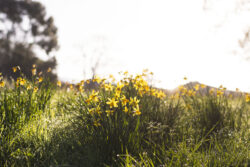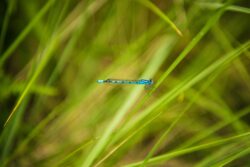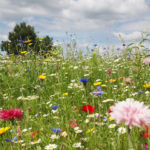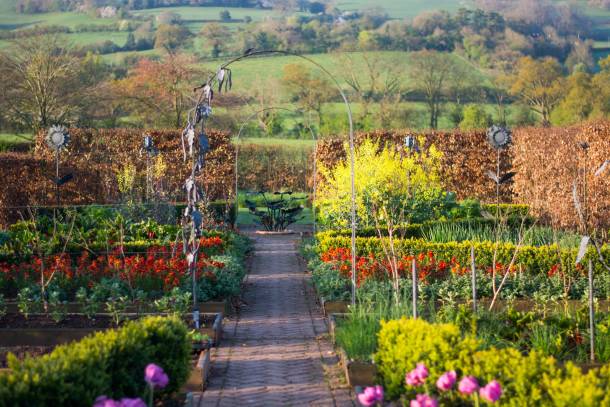Wednesday 26th April 2023
“If you only do one thing this year to improve your garden’s value for nature cut your grass less, or not at all,” says our very own Sarah Mead, creator of the Yeo Valley Organic Garden. “Come on gardeners, would a little less cutting really be such a bad thing?!”

The UK’s climate is perfectly suited to allow grass and the many species of beneficial plants that share our lawns to thrive, but regular cutting deprives essential pollinators of an important food source. According to PlantLife, the British conservation charity behind the No Mow May initiative, allowing your lawn to grow naturally for just a single month can provide enough nectar for ten times the number of bees and other pollinators than a regularly cut lawn. In fact, the average lawn produced enough nectar each day to support 1088 honeybees!

Sarah continues, “Global biodiversity is in decline and our climate is warming. It’s essential that we all recognise the small changes we can make that have a huge collective impact on our environment. Putting your feet up instead of getting the mower out is top of the list!”
The Yeo Valley Organic Garden is supporting PlantLife’s No Mow May challenge again this year and taking part in the charity’s Every Flower Counts campaign. The garden team will be showing, not only throughout the month but also the rest of the year, how less cutting not only improves your lawn’s value for nature but can also provide a fun and cheap way to add more interest to your garden’s design. In the Yeo Valley Organic Garden, 2/3 of the grass will not be mowed at all, leaving only the heavy footfall areas regularly trimmed. In addition, all garden tools, including mowers, are now powered electronically, eliminating the need for fossil fuels and making garden maintenance quieter for both people and wildlife.

You’re only FIVE steps away from a wildlife rich lawn:
-
- Give your lawn an early spring trim to tidy up winter growth and then decide which parts of your lawn you can comfortably allow to grow long in 2022.
- Why not turn over some of your existing lawn to annual meadows instead. At YOG we had two areas of formal lawn that are now a riot of low maintenance colour every year. We took the decision to strip the turf off (composting it down for later use in potting mixes) and sow an annual flower mix instead. The resulting carpet of blooms attracts mases of pollinators and flowers nonstop from June until October, with absolutely no effort from us!
- Alternatively, you could introduce spring bulbs and/or plug plants into existing grass to make the most of your new ‘no mow’ area. Also, if you have lovely early flowers blooming in your grass you certainly won’t be wanting to mow it. Good candidates are crocus tommasinianus, narcissus, cowslips and if you have a wet area camassias – All of which have finished flowering by the end of June when you can mow over them – if you must!
- Commit to only cutting the areas you need to keep short, for example for ease of movement around the garden and children’s ball games
- Try cutting a trail or maze into your longer grass and listen to the buzz of pollinators as you wander through
Sarah’s inspirational, seasonal planting and sympathetic design offer great ideas for how to choose organic principles in your own garden while enjoying year-round colour and form. So why not come and see?
Our garden gates are open to visitors for the season but tickets need to be pre-booked. For information on how to book, click here to head to the Organic Garden page.
Photo credit: Studio Whisk





Luv It! This article by Sarah on the lawns fascinating I feel massively educated now on grass and lawns. I do actually leave my lawns at clover bee time and get loads of bees. Only problem, my Irish Setter becomes a super-young puppy again (at 5+).
Have half acre of useless arable – a good friend who seriously keeps bees (several hives). Wife and I love runny-honey!
As retired photographer, starting a new micro business at 81 yrs out of necessity. Do Wall Arts so maybe advance utilising these possibilities!!
No Mow May is for me. CRK
We would have the anthill problem (the area we haven’t mown for 20 years is unwalkable); however, mowing on the highest setting enables low growing speedwell, clover, dandelions, buttercups, yarrow and other wildflowers/herbs to flourish in the main lawn, with narrow uncut long grass areas at the edges.
I persuaded my husband to do no mo May. We have a large area of grass and as he says what are we going to do with all the cut grass, usually it is mixed in with other garden waste. However the lawn is covered in daisies and dandelions. It is a shame weather is so bad as the bees are not around and there is a lack of butterflies.
I live at the Cheddar end of Axbridge close to your site on the main road. at the rear of my small small road we we have a communal green area that the council cut. 5 years ago I discovered bee orchids growing and since then I was told to put white sticks to them so they did not get cut. Last year due to covid it was not cut until midsummer. We had over 60 different types. Now sadly due to the dry April many have dried up. But the area is covered with Red Clover Buttercups a small trefoil that only grows in the West,Daisies purple vetch more flowers are appearing. It is covered. I wish I could photo it for you. The Council grass cutter when he came 2 weeks ago told me he is leaving areas when he can in other places he loves to see the flowers himself. He just trimmed down one edge.
I should add before retiring to Somerset I had a small farm with a conservation grant scheme. So this was a life line for me to be able to continue to do something to help.
Trying no mow May. Lots of dandelions and daisies so far. Clover leaves visible but it’s early yet. Have been gardening here for 25 years as ecologically as I can (no chemical sprays, goodness from my wormery and my own organic compost bin). Have bluetits and wrens nesting in the boxes, hedgehog visitors and plenty of bees though have noticed a dramatic decline in butterflies, sadly.
For years I’ve been a wild gardener, which for me pretty much means I let things grow where they seed and only trim back when they’re really getting overgrown or annoying or ill. I haven’t cut my grass at all this year, and we have forget-me-not growing in the lawn, as well as dandelions, dock and several types of grass. I plan to do a gentle cut in the summer, while trying to leave the flowers that are growing through the grass to continue. I also feed the birds all the year round and encourage others to do the same.
We are going to make the back area of the garden into a wild garden. I had never heard of No Mow May, but am now a convert. We just cut a path through what is an under used space and will set about sewing seeds at the correct time. Thank you Yeo Valley for the inspiration. 🤗
Loved this idea and am following it So are neighbours
My heart breaks as I see the fields and wild life that have been allowed to thrive for years being totally destroy. The building on waste land in the south east is phenomenal. The wild life is moving more and more into our gardens. For instance for the last two years I have had hundreds of ladybirds descend on the tiles on the back of my house and last year I happened to notice bumble bees making a home in my compost bin. I could quite easily if destroyed these natural habitats if I hadn’t been aware. How much more is being destroyed by building. I’m doing as much as I can to support the wild life in my area but I find it soul destroying to see the devastation caused by people’s ignorance. Thank goodness there are people like you. Long may you continue.